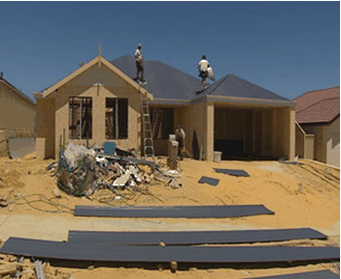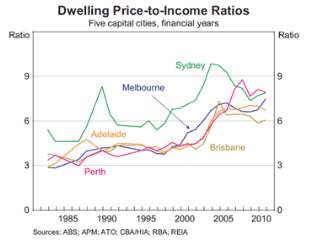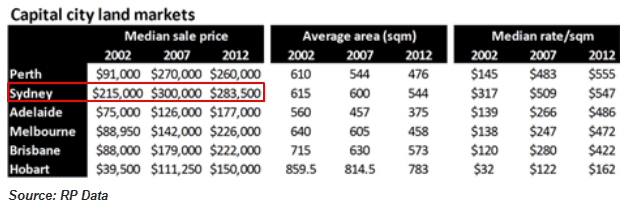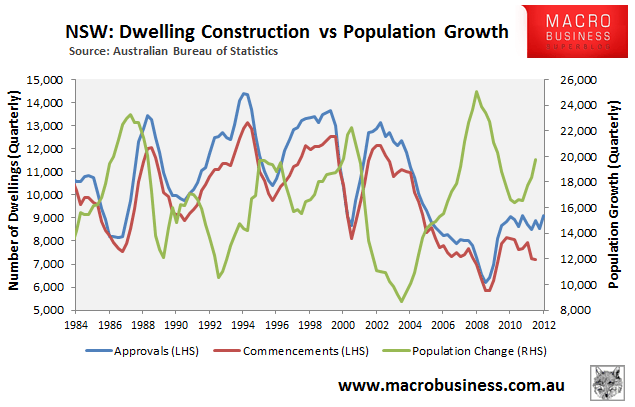
For decades, housing affordability in Sydney has been stretched, with homes typically costing far more than the other capitals when measured against incomes (see next chart).

Underpinning the higher home prices are Sydney’s land values which were, for a long time, out of kilter with Australia’s other capitals (see next table).

The rate of new dwelling construction in Sydney has also collapsed over the past decade just as the city’s population growth boomed (see next chart).

The election of the O’Farrell Government in 2011 appears to have ushered in a pradigm shift in housing policy, eschewing the former government’s preception that “Sydney is full” in favour of greater openness to urban growth.
In October last year, the O’Farrell Government abolished the $7,000 First Home Owner’s Grant (FHOG) on pre-existing dwellings, replacing it with a $15,000 grant for purchases of new properties up to $650,000. The first home buyer stamp duty exemption, which applied to new homes only, was also extended to homes valued up to $650,000 (up from $600,000 previously). And the Government also offered a New Home Grant of $5,000 to all non-first homebuyers of new properties up to $650,000, and vacant land up to $450,000 from 1 July 2012.
In addition to the cash grants, the Government announced that it would establish a $561 million fund to pay for road and sewerage infrastructure in new housing estates, with the explicit aim of stimulating housing supply in order to cater for Sydney’s population growth.
Over the weekend, the O’Farrell Government announced an ambitious plan to speed-up the supply of 172,000 new homes across Sydney, most of which will be on greenfield sites:
Eight existing suburbs will be re-zoned to accommodate 30,000 new homes in high density apartment blocks.
The Government has also released greenfield sites on the city’s north-west and south-west outskirts to build new houses, business parks and town centres over the next 20 years…
Premier Barry O’Farrell says the plan will meet the city’s future housing needs.
“It’s about ensuring that areas open up as the infrastructure is available,” he said. “It’s about better balancing the needs of this city.
“Ultimately economics drives everything.
“Our argument is the more blocks of land we can release the greater downward pressure we can put on housing.
“It has been so high for so long because under the former government not enough housing was developed because not enough land was being released.”
Speaking at one of the proposed sites, planning minister Brad Hazzard said the plan would solve the city’s housing shortage and curb rising prices…
The roads and transport to support the plan will be funded from the Government’s $62 billion infrastructure fund.
And later today, the Government is expected to announce the 20-year Draft Metropolitan Strategy Plan, which will set the highest targets yet for the construction of new houses and units and the creation of jobs. From the AFR:
The far reaching plan will be underpinned by a new Land Release Policy to speed up the creation of new housing and commercial land in the metropolitan area.
Premier Barry O’Farrell and Planning Minister Brad Hazzard will unveil plans for 545,000 new homes to house 1.3 million people in the region by 2033.
The figure is 17 per cent higher than the previous Labor government envisaged in its 2010 Metropolitan Plan.
To reach the target, Sydney will have to build 27,250 houses and units a year – a figure almost 90 per cent higher than the hard hit industry has created in any 12 months over the past five years.
Significantly, the draft strategy will not split the target between new “greenfield” housing on the fringe or “brownfield” housing on redeveloped inner and middle ring sites. Sydney has long built a high proportion of its housing, at times more than 80 per cent, at medium to high density and over considerable resident opposition in existing suburbs.
Prior to his election in 2011, Mr O’Farrell said a higher proportion of homes could be built on green fields sites…
Mr Hazzard said the government was “freeing up the bottlenecks that have restricted housing supply, which have pushed up house prices in Sydney”…
The Draft Metropolitan Strategy is expected to outline ways to explore fast track rezoning for large scale projects that have the backing of both local government and the private sector.
It will also need to link the new releases to infrastructure…
The strategy aims to create 625,00 jobs across the metropolitan area, a figure that is 33 per cent higher than the Labor government’s target that was set in 2010.
The release of the strategy could also pave the way for the O’Farrell government to release its long-awaited white paper on the state’s new planning system.
Certainly, the O’Farrell Government’s announcements are a big step in the right direction for Sydney housing, and should help aleviate some of the pressures on house prices and rents.
That said, even with more relaxed planning, Sydney land supply will remain geographically constrained, hemmed-in by the ocean, state parks, and the Blue Mountains. As such, housing affordability is likely to remain stretched, as long as population pressures persist.

